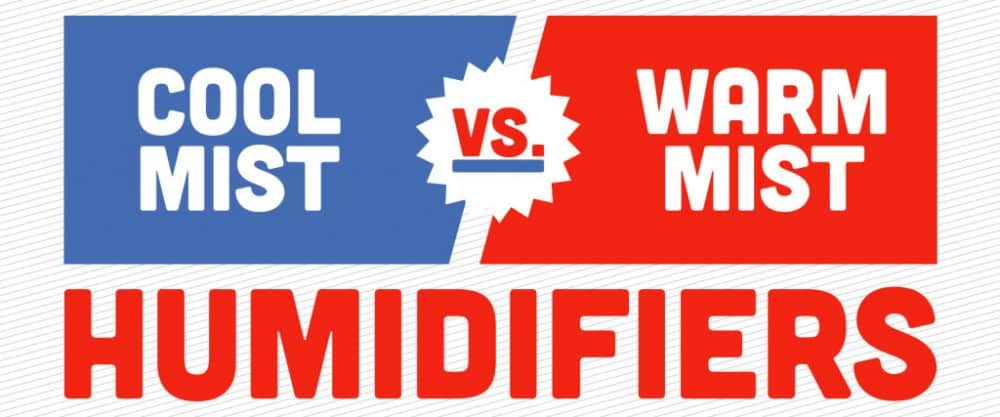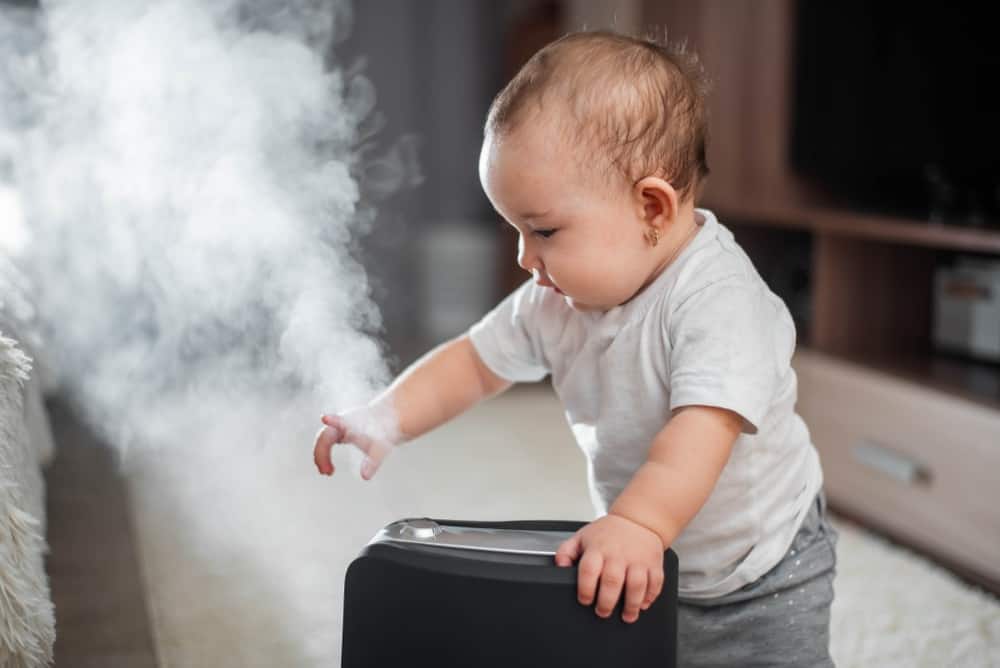Shopping for the perfect humidifier? Before you can pick out a model, you’ll need to work out which type you’d prefer.
Humidifiers are always split into two distinct categories: warm mist humidifiers, and their cool mist cousins.
Warm mist humidifiers boil water to fill your baby’s bedroom with warm, moist vapor while cold mist models use either cool wick or ultrasonic technologies to raise the humidity without raising the ambient temperature in your nursery.
[toc]Humidifiers Fight: Warm Mist vs Cool Mist
Generally speaking, warm and cold mist humidifiers are both equally good at increasing overall moisture levels in an average-sized bedroom.
Both types will help to combat the natural dryness of winter air, and they’ll also both do an equally good job of preventing dry skin, chapped lips and sore noses.
There are some important differences between the two different types of humidifier though. Particularly when it comes to effectiveness, safety, and ease of use.
In this guide, we’ll talk you through the pluses and minuses of each as follows:
Easing respiratory distress (cool mist humidifiers are slightly better)
One of the main benefits of a humidifier is its ability to provide your baby with relief from congestion, a blocked nose or other, flu-like symptoms.
This is particularly important if your baby is too young for common cough medicines, and is struggling to breathe comfortably.

Warm mist humidifiers do still help to alleviate the overwhelming majority of cold- and flu-type symptoms, they’re just not quite as efficient, and this may make them slightly less desirable if helping your baby to breathe is your number one priority.
Creating a germ-free environment (warm mist humidifiers did a better job)
Paradoxically, similar studies have shown that warm mist humidifiers are actually slightly better at creating a germ-free environment.
According to this article from the Huffington Post, the vapor that they put out is much less likely to contain harmful bacteria (probably as a result of the water having been boiled first) which means that you’re much less likely to accidentally introduce your baby to a new illness.
This is particularly important in winter, when your little one’s immune system will be slightly suppressed. It’s also particularly important if your baby is already suffering from an illness.
Ill babies have to use most of their energy to fight off their ailment, which means that there’s very little left to fight off new pathogens.
If you’re running a humidifier for general benefits to your baby’s health and wellbeing, but don’t want them to fall ill, a warm mist humidifier is probably the right choice.
Combining with decongestant sprays – warm mist humidifiers win
Warm mist humidifiers are also the only choice if you want to disperse a decongestant like Vicks. These decongestants, when added to a humidifier’s water tank, imbue the resultant vapor with the ability to actively break down mucus, which can be hugely beneficial if your baby is suffering with a stuffy nose.
These decongestants need to be heated in order to dissolve and disperse correctly, which means that you’ll need a warm mist humidifier like this model from Vicks if you plan to use them. If you have a very young baby, you will also need to read the pamphlet that comes with your chosen decongestant to ensure that it is suitable for very young children.
Generally speaking, most pediatricians will tell you that the use of a decongestant is unnecessary, particularly if your little one is just a bit bunged up. That said, if the symptoms are fairly severe, they can make all the difference and it is important to factor this into the decision-making process if you don’t expect your child to be ill quite a lot.
Raising moisture levels – cold mist humidifier wins
Another important consideration is the efficiency with which humidifiers can increase the moisture content of the air in your baby’s bedroom. This is particularly important if you’re mainly interested in a humidifier’s ability to prevent chapped lips or dry skin.
For the most part, efficiency is model-dependent and correlates to the quality of the unit. That said, there is some evidence to suggest that cold mist humidifiers are slightly better at raising humidity - particularly in large rooms with high ceilings.
This is because the vapor that they create spreads out evenly, where the warmer vapor provided by a warm mist humidifier would rise up towards the ceiling instead.
Creating a safe environment - cold mist is beter
Cold mist humidifiers are also slightly safer too - because of the way they work, warm mist humidifiers will always have a tank of heated water, which can be spilt by wandering hands or thrown toys.
If you plan to keep your humidifier close to your baby, it’s important to understand that this can pose a health risk. This is largely mitigated by placing the humidifier out of reach, on a windowsill or cabinet.
And it’s also worth pointing out that cold mist humidifiers have their fair share of health and safety concerns too. Because they don’t boil the water that they’re filled with, they create an environment that can allow germs, mould and fungi to breed indiscriminately, which means that regular cleaning (with dish soap) is a must.

If you’re a busy parent without much free time, a warm mist humidifier will be easier to use and less finicky to maintain.
Running costs - depends on requirement
Warm mist humidifiers are also more expensive to run. This is because they have to heat water, which is a very energy-inefficient process, while cold mist humidifiers use less costly ultrasonic or wick-based technologies instead.
The difference is only slight, but if you’re very budget conscious, this might make all of the difference.
You may also like: Best Baby Humidifiers (Guide and Reviews)
Keep Your Humidifiers Clean
We made all above comparisons on the basis that your humidifiers are working with a clean tank. According to a research sponsored by Consumer Products Safety Commission (CPSC) decades ago, home humidifiers, especially ultrasonic and cool-mist units, may become potential source of pathogens, and therefore compromise human health.
Researchers found that all impurities in the tank are also present in the vapor from home humidifiers.
To avoid living with a germ generator in your room, here are some essential tips:
- Clean your humidifiers regularly,
- Keep the humidity level in your home between 30% – 50%. Indoor surfaces may become a breeding ground if humidity level goes above 60%, which leads moisture to condense on those surfaces.
- Try not to use furnace humidifiers. They are not easy to clean and may hide more bacteria and mold.
Medical practitioners also warned that users should maintain their humidifiers properly and monitor the humidity level with a hygrometer or humidistat. TaoTronics has a humidifier model with built-in humidistat.
Final Words
In conclusion, cold mist humidifiers are slightly less effective at helping your child to fight off winter illnesses. But, they do make better background humidifiers - affecting more of the room, and taking the edge off respiratory distress of any type.
Warm mist humidifiers are more expensive to run and, generally speaking, more expensive to buy. However, they are better at keeping out germs, and they require much less maintenance.
Ultimately, your decision will be based on the priorities that are most important to you, as a parent.




 Best Car Seats (Impartial Review 2020)
Best Car Seats (Impartial Review 2020)
An older article, but says “A study completed in 1989 at the Oak Ridge (Tenn.) National Laboratories found that ultrasonic and cool-mist units released the most bacteria, while warm-mist units released insignificant amounts. The study also found that cool-mist units released significant levels of mold.”: https://www.nytimes.com/1991/01/12/news/the-search-for-a-safer-humidifier.html
Hi Shiloh, thanks for your comment and happy new year! I knew the article you mentioned and it’s probably sourced from this research – Home Humidifiers as A Potential Source of Exposure to Microbial Pathogens, Endotoxins, And Allergens, by Richard L. Tyndall with Oak Ridge National Lab and a bunch of other scientists.
Sorry that I can’t elaborate on what this report has discussed about. However, for those who’re interested, you can read the whole report at https://fdocuments.in/document/home-humidifiers-as-a-potential-source-of-exposure-to-microbial-pathogens.html
To save your time, here is the yummy reader-friendly takeaway: we made above comparisons with one condition that all humidifiers are used properly with good maintenance. In a word, keep your humidifier clean! Otherwise, they could be a hotbed of germs and allergens.
We’ll soon provide more information in this regard in our next update as an alert of use. Thanks to Shiloh and all other readers. It’s because of you that we could do better!